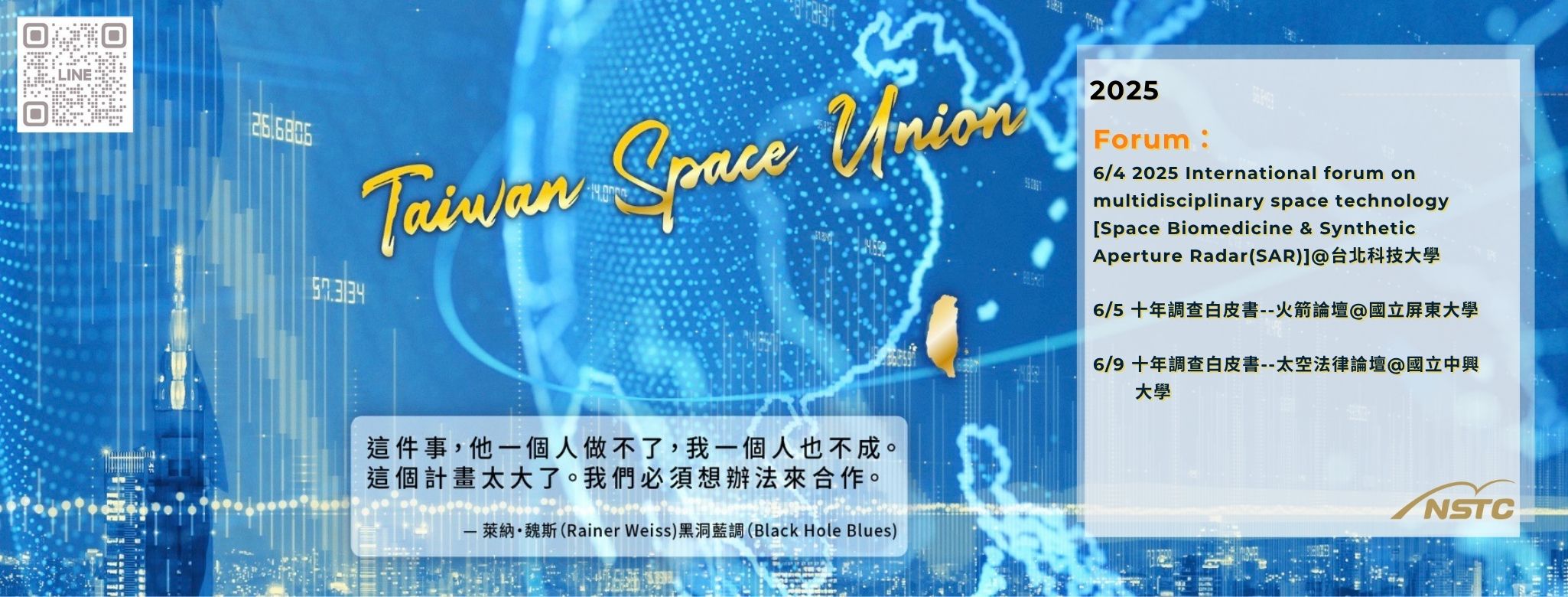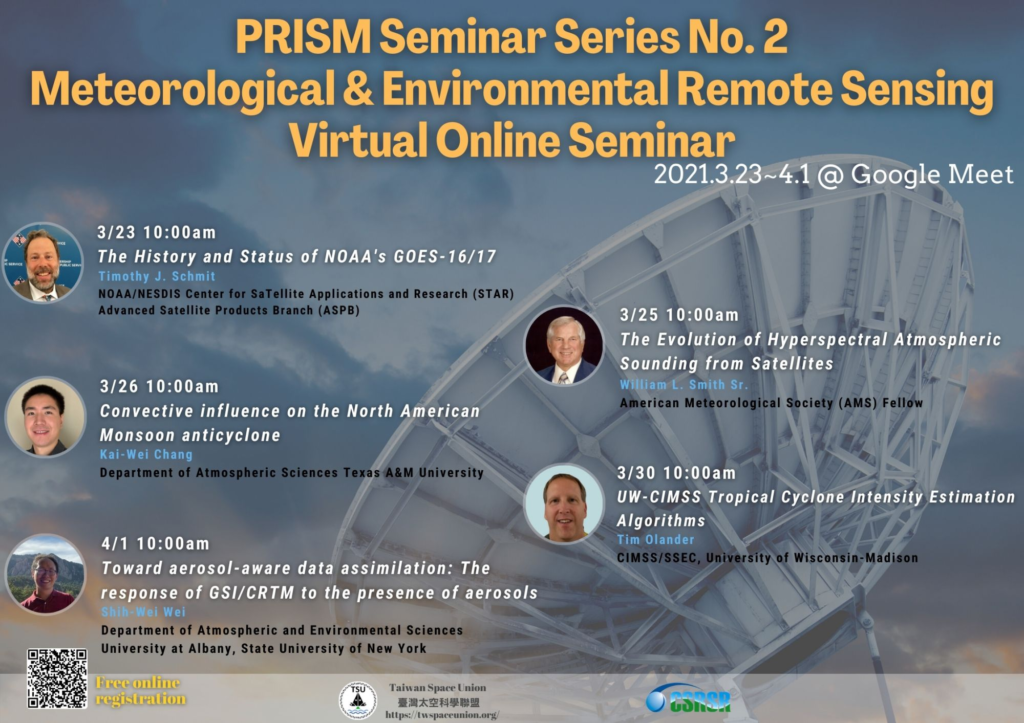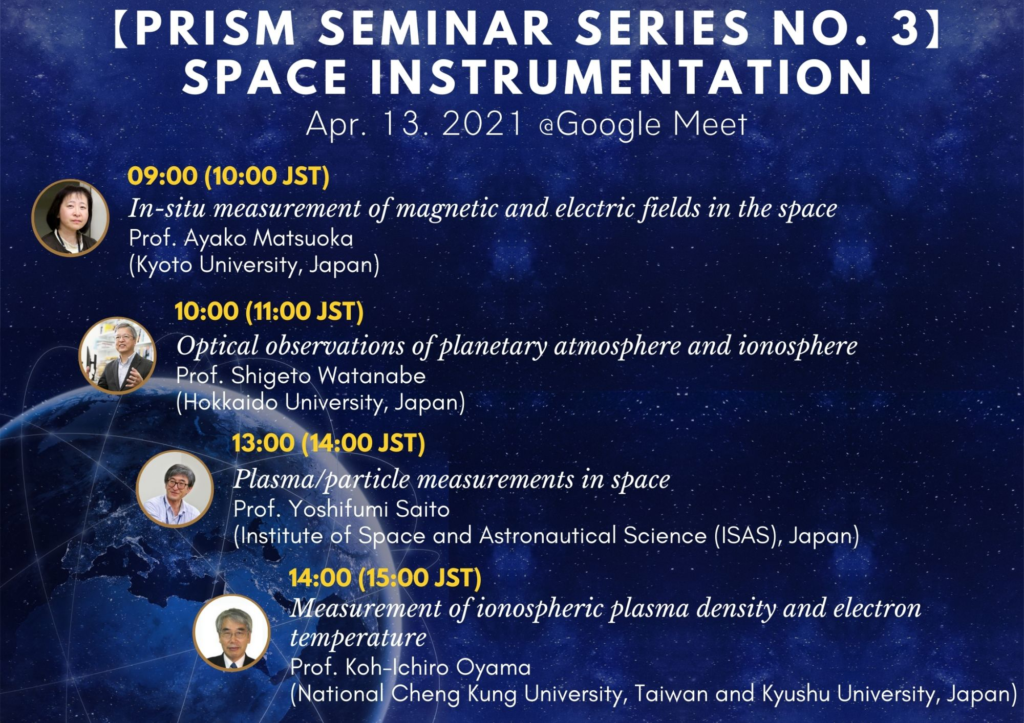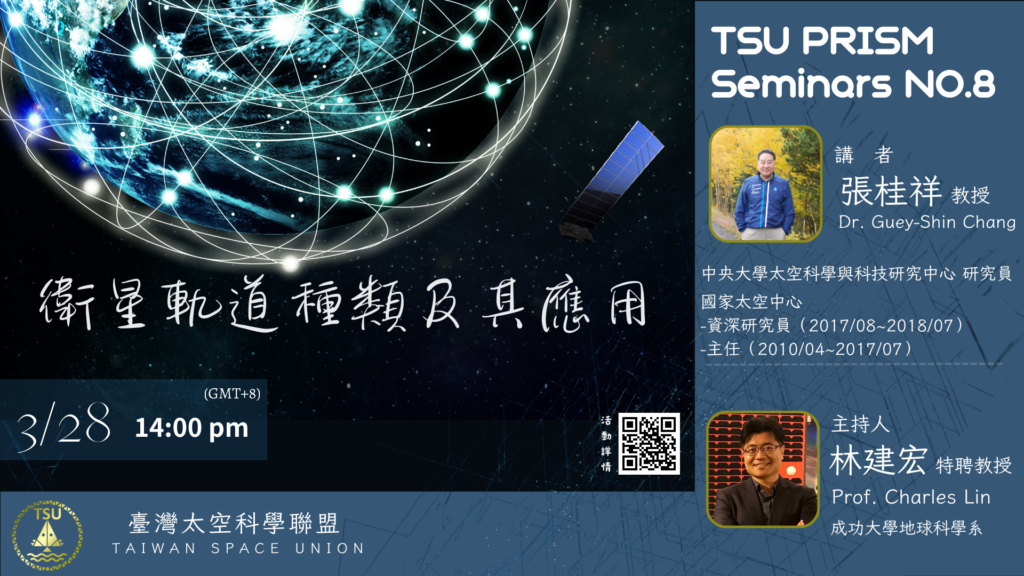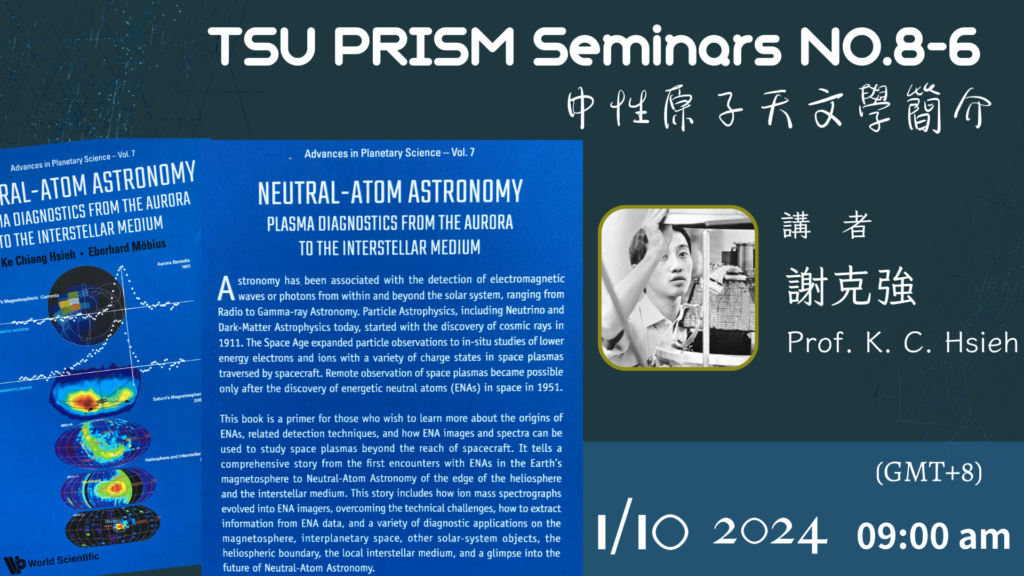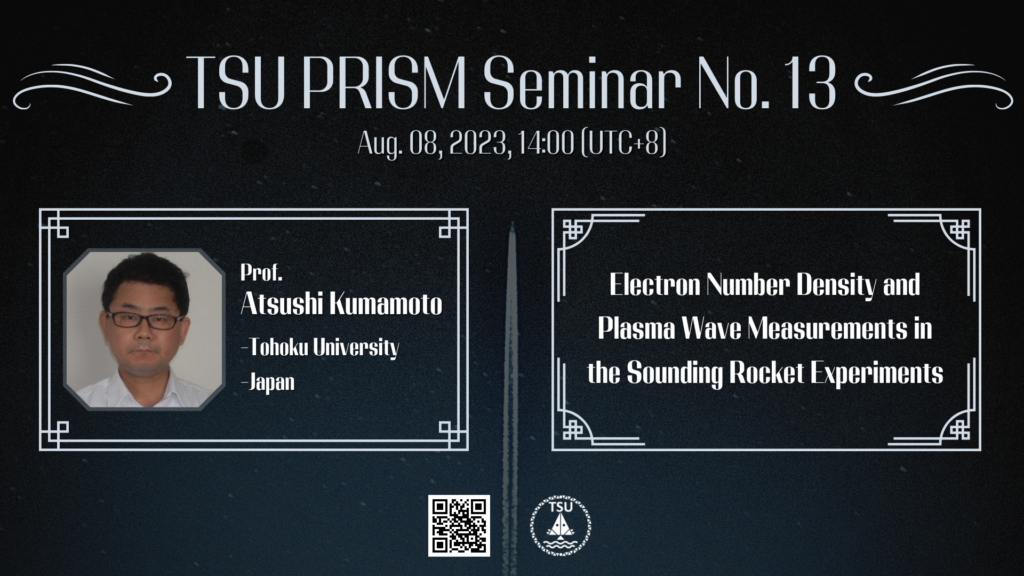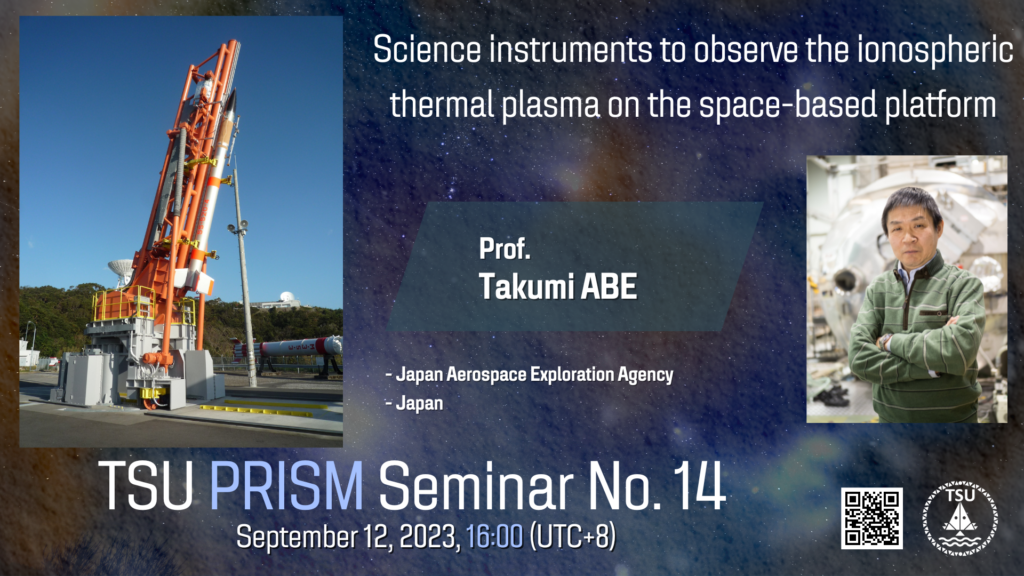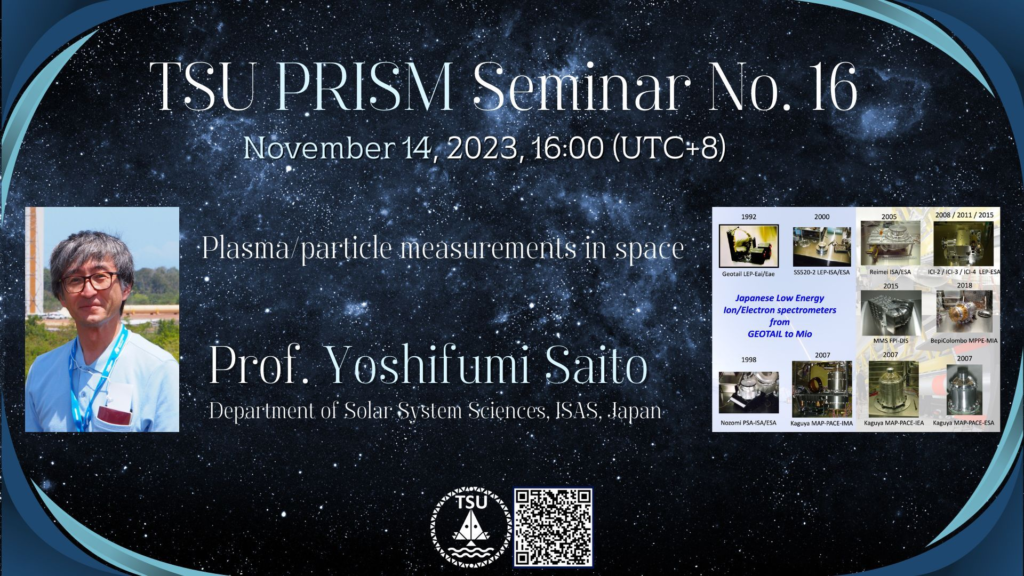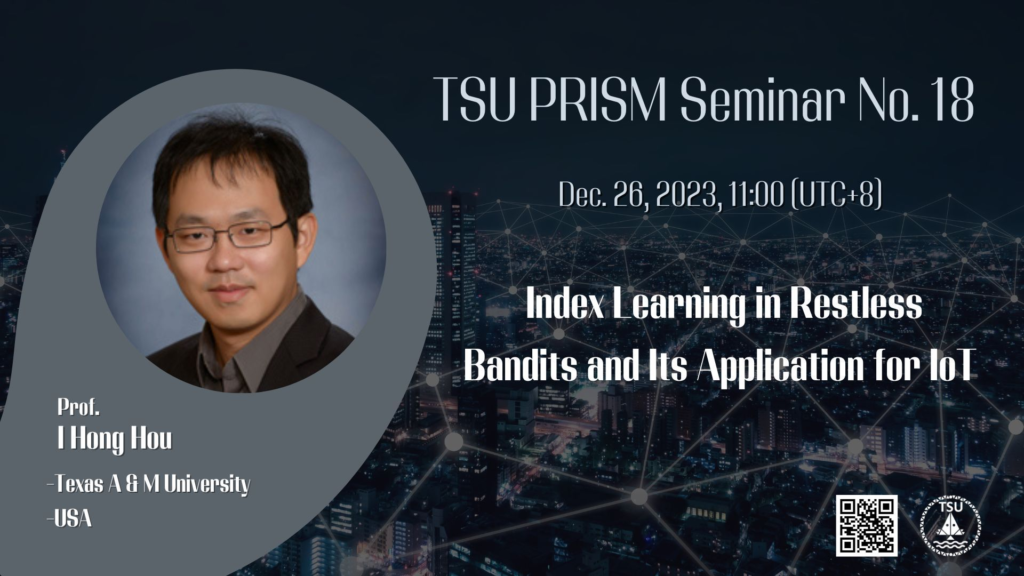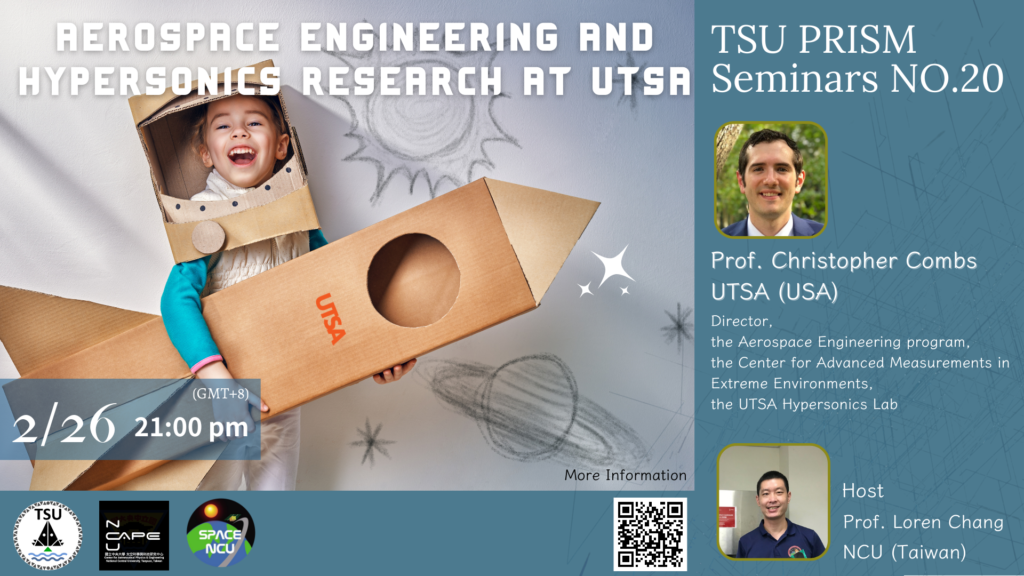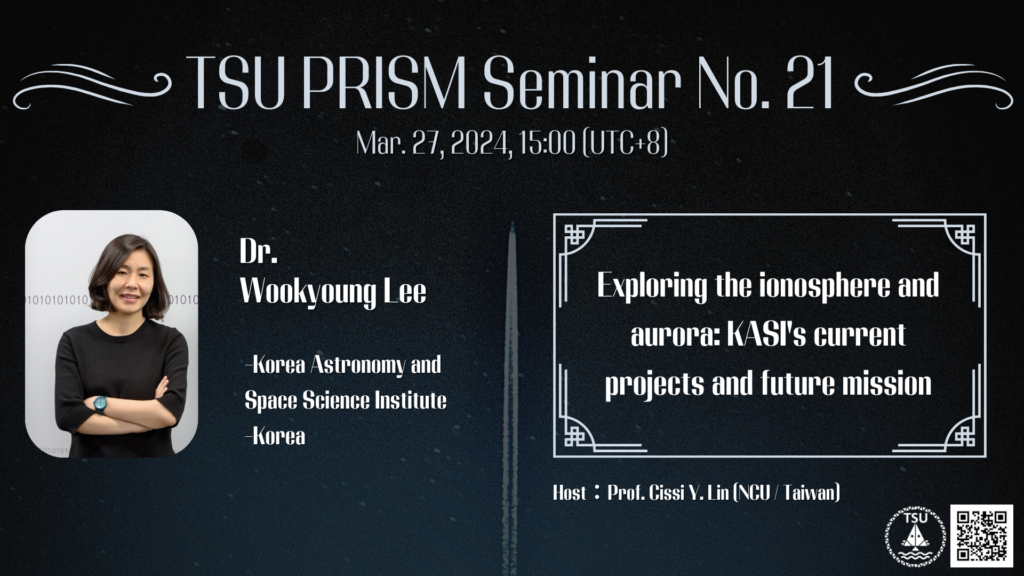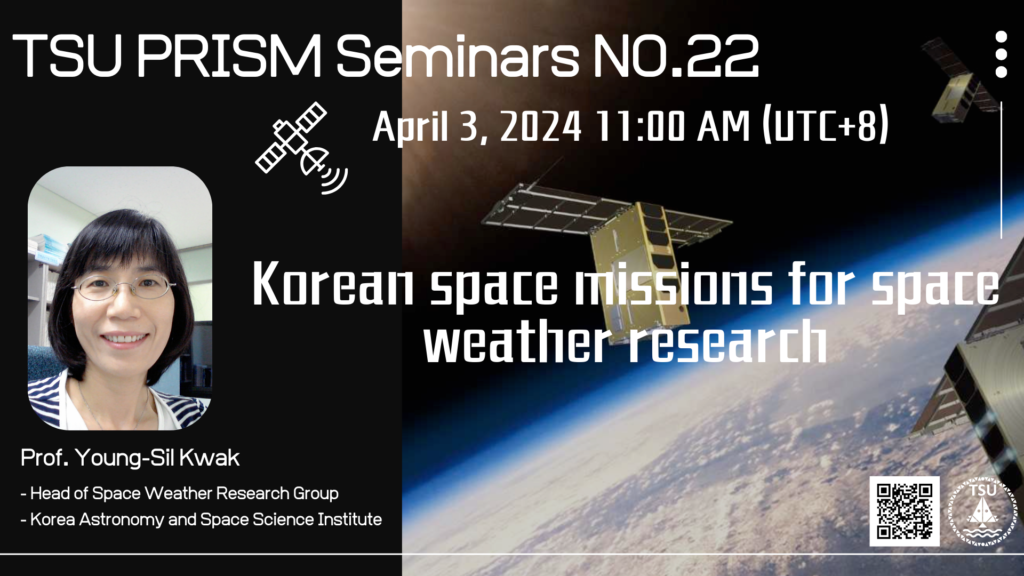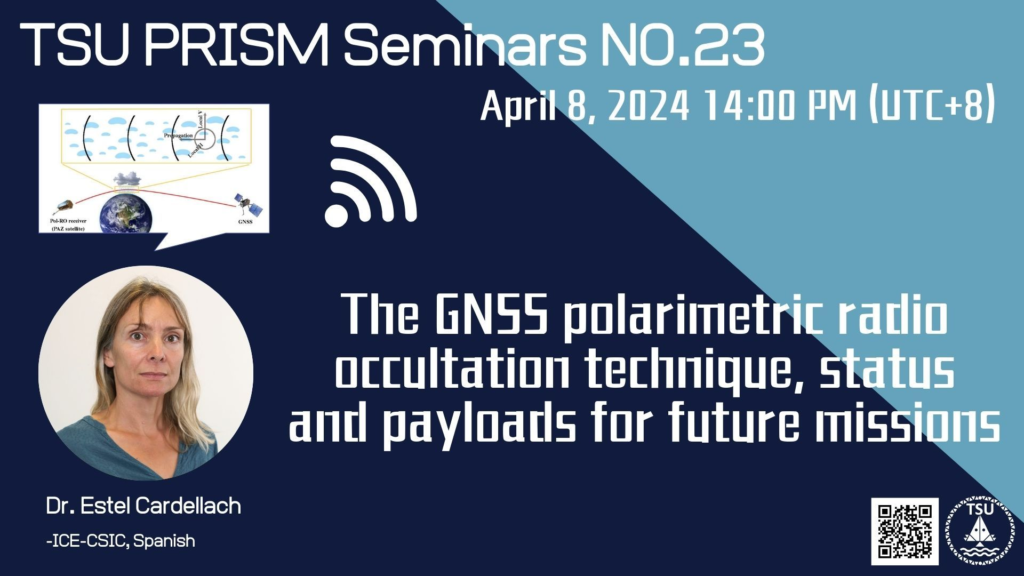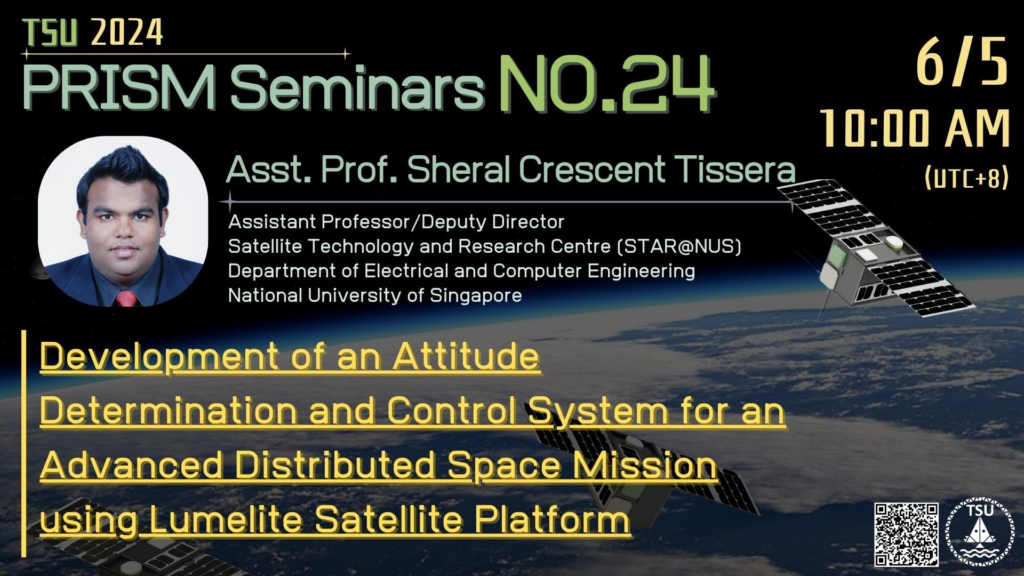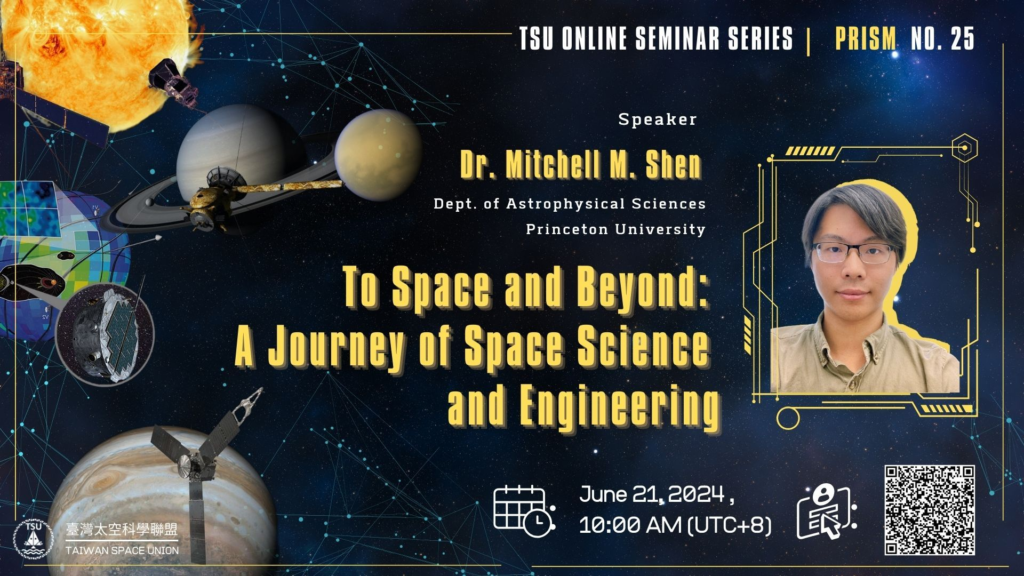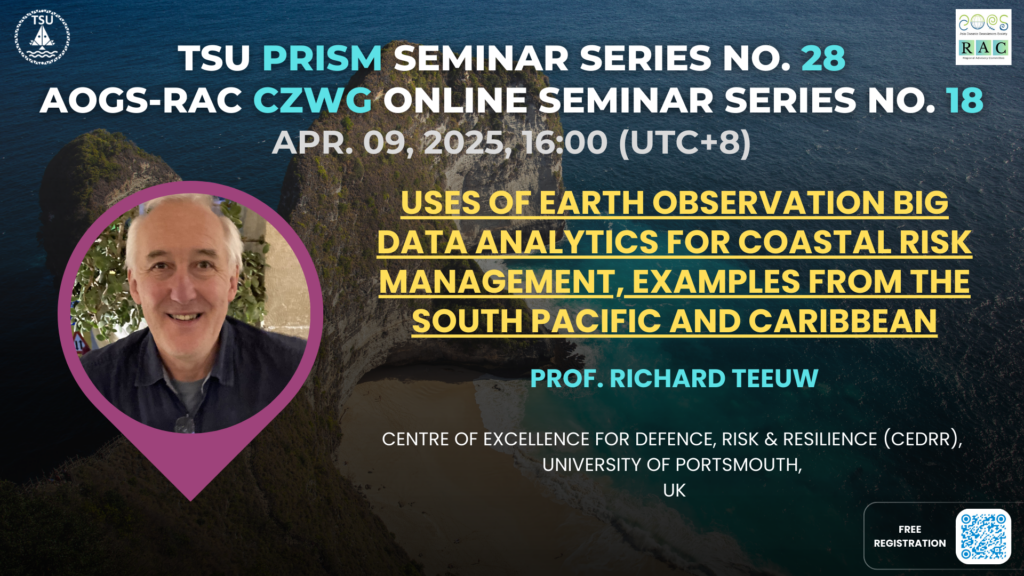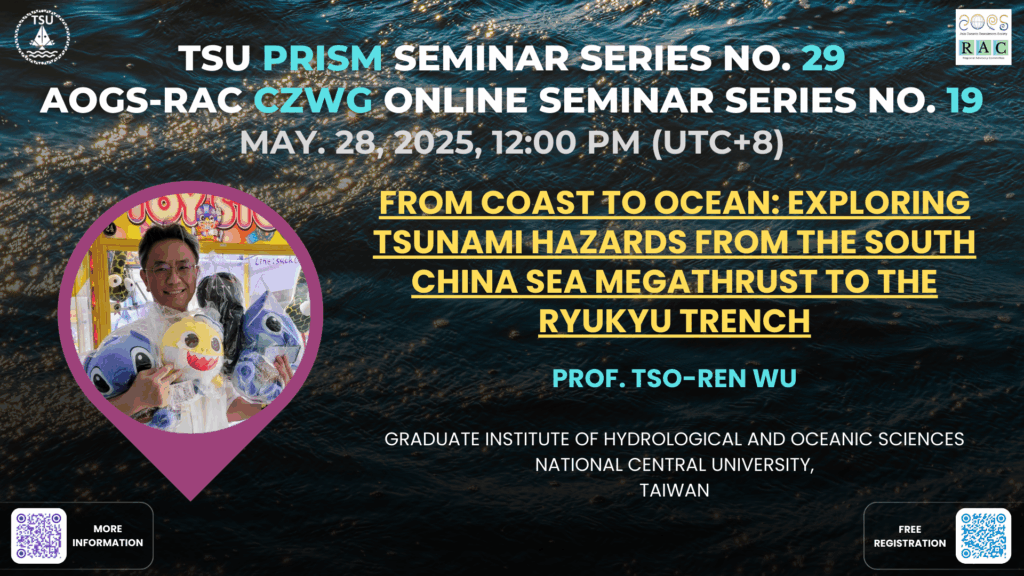國家太空中心的第三期計畫將加深加廣各項遙測衛星的工程技術和科學研究。其中福8的星系假如配合其它多元影像資料(如SAR)預期會帶來很多環境監測、國土規劃和太空産業的軟體加值應用。而福7及福9的GNSS-RO和GNSS-R技術更是新一波的前沿發展,如果加上B5G的太空技術,將會使臺灣的太空計畫進入一個全新的境界。除此之外,科學酬載的研發以及資料的處理和分析等工作都是太空科技發展不能缺乏的重點,亦是我們要努力的方向。TSU 的稜鏡(PRISM) 線上演講系列便是一方面用來盤點國內學界,政府單位及産業界的成果和進度,另一方面則作為與國際同行交流和互相學習的平台。 當然了,顧名思義,這個PRISM演講系列也是要提醒我們亮光是由各種不同的光譜合成的,大家一定要合作。

PRISM List
1. F7 Mission/Cosmic-2
Radio occultation: Message from signal path, Vicky Chu (1)
FORMOSAT-7/COSMIC-2 Radio Occultation Data in the Troposphere and the
Application of GNSS Data in Numerical Weather Prediction, Shu-Ya Chen (1)
Exploring the Geospace Dynamics using FORMOSAT-7/COSMIC-2, Charles Lin (1)
2. F8 Mission
Introduction to Formosat-8 Remote Sensing Satellite Program, Steven C.R. Chen (1)
The Gamma-ray Transients Monitor (GTM) on board FS-8B, Hsiang-Kuang Chang (1)
3. GNSS-R : Instrument, Data processing and Calibration
CYGNSS Mission Overview, Chris Ruf (4)
Current status of TRITON mission, Yung-Fu Tsai (4)
Overview of CYGNSS Level 1 Data Products and Lessons Learned, Mohammad Al- Khaldi (4)
Processing and Calibration in the TRITON GNSS-R Receiver, Jyh-Ching Juang (4)
Combining the new ocean observations for a new wind speed retrieval algorithm, Hua Chien (4)
Ocean surface wind retrieval using CYGNSS GNSS-R measurements, Rajeswari Balasubramaniam (4)
The software-based GPS-R receiving network in Taiwan for ocean monitoring, Lung- Chih Tsai (4)
Cyclone Global Navigation Satellite System (CYGNSS) Air-Sea Flux Applications, Derek Posselt (4)
Assimilation of CYGNSS Data for Improved Hurricane Analysis and Prediction, Zhaoxia Pu (4)
A primer on soil moisture and GNSS-R, Clara Chew (4)
On the use of CYGNSS for inland water applications, Hugo Carreno (4)
Impact of assimilating the GNSS-R wind data on severe weather prediction, Shu-Chih Yang (4)
Spaceborne GNSS Reflectometry for Remote Sensing of Ionosphere, Atmosphere, Oceans, and Inland Water Bodies, Jade Morton (19)
The GNSS polarimetric radio occultation technique, status and payloads for future missions, Estel Cardellach (23)
4. Space Instrumentation
In-situ measurement of magnetic and electric fields in the space, Ayako Matsuoka (3)
Optical observations of planetary atmosphere and ionosphere, Shigeto Watanabe (3)
Plasma/particle measurements in space, Yoshifumi Saito (3)
Measurement of ionospheric plasma density and electron temperature, Koh-Ichiro Oyama (3)
The Submillimetre Wave Instrument on JUICE: science goals and technical challenges, Paul Hartogh (9)
Lithium cloud experiment to measure neural wind in the lower thermosphere, Shigeto Watanabe (10)
Electron Number Density and Plasma Wave Measurements in the Sounding Rocket Experiments, Atsushi Kumamoto (13)
Science instruments to observe the ionospheric thermal plasma on the space-based platform, Takumi ABE (14)
Infrasound, inaudible over-pressure waves coupled with many kinds of geophysical events in the atmosphere, Masa-yuki YAMAMOTO 15)
Plasma/particle measurements in space, Youshifumi Saito (16)
Exploring the ionosphere and aurora: KASI’s current projects and future mission, Wookyoung Lee (21)
Korean space missions for space weather research, Young-Sil Kwak (22)
To Space and Beyond: A Journey of Space Science and Engineering, Mitchell M. Shen (25)
5. Meteorological & Environmental Remote Sensing Virtual Online Seminar
The History and Status of NOAA’s GOES-16/17(and a glimpse to the future), Timothy Schmit (2)
Very First Atmospheric Vertical Sounding Measurements from Space NIMBUS 1969 / The Evolution of Hyperspectral Atmospheric Soundings from Satellites, William L. Smith Sr. (2)
Convective influence on the North American Monsoon anticyclone, Kai-Wei Chang (2)
UW-CIMSS Tropical Cyclone Intensity Estimation Algorithms, Tim Olander (2)
Toward aerosol aware data assimilation The response of GSI CRTM to the presence of aerosols, Shih-Wei Wei (2)
Introduction to Synthetic Aperture Radar, Koo Voon Chet (5)
Big SAR data intelligence in InSAR and PolSAR, Akira Hirose (5)
Monitoring Natural Hazards by InSAR: Challenge and Perspective, Jyr-Ching Hu (5)
The Principles of Synthetic Aperture Radar (SAR) Imaging, Chiung-Shen Ku (5)
Uses of Earth Observation big data analytics for coastal risk management, examples from the South Pacific and Caribbean, Richard Teeuw (28)
From Coast to Ocean: Exploring Tsunami Hazards from the South China Sea Megathrust to the Ryukyu Trench, Tso-Ren Wu (29)
6. Space System Engineering
如何有效執行衛星計畫, 祝飛鴻教授(8)
衛星軌道種類及其應用, 張桂祥教授(8)
衛星本體架構簡介, 張桂祥教授(8)
衛星計畫執行實例, 祝飛鴻教授(8)
Aerospace Engineering and Hypersonics Research at UTSA, Christopher Combs (20)
Development of an Attitude Determination and Control System for an Advanced Distributed Space Mission using Lumelite Satellite Platform, Sheral Crescent Tissera (24)
7. Cubesat
Space weather cubesat: Lessons learned from the Suomi 100 cubesat project, Kallio Esa(7)
Coulomb Drag Propulsion, Pekka Janhunen(11)
Optical Remote Sensing of the Earth from Nano/Microsatellites, Junichi Kurihara(12)
8. New space activity
Luxemburg Space Ecosystem, Jordan Vannitsen(6)
Index Learning in Restless Bandits and Its Application for IoT, I-Hong Hou (18)
